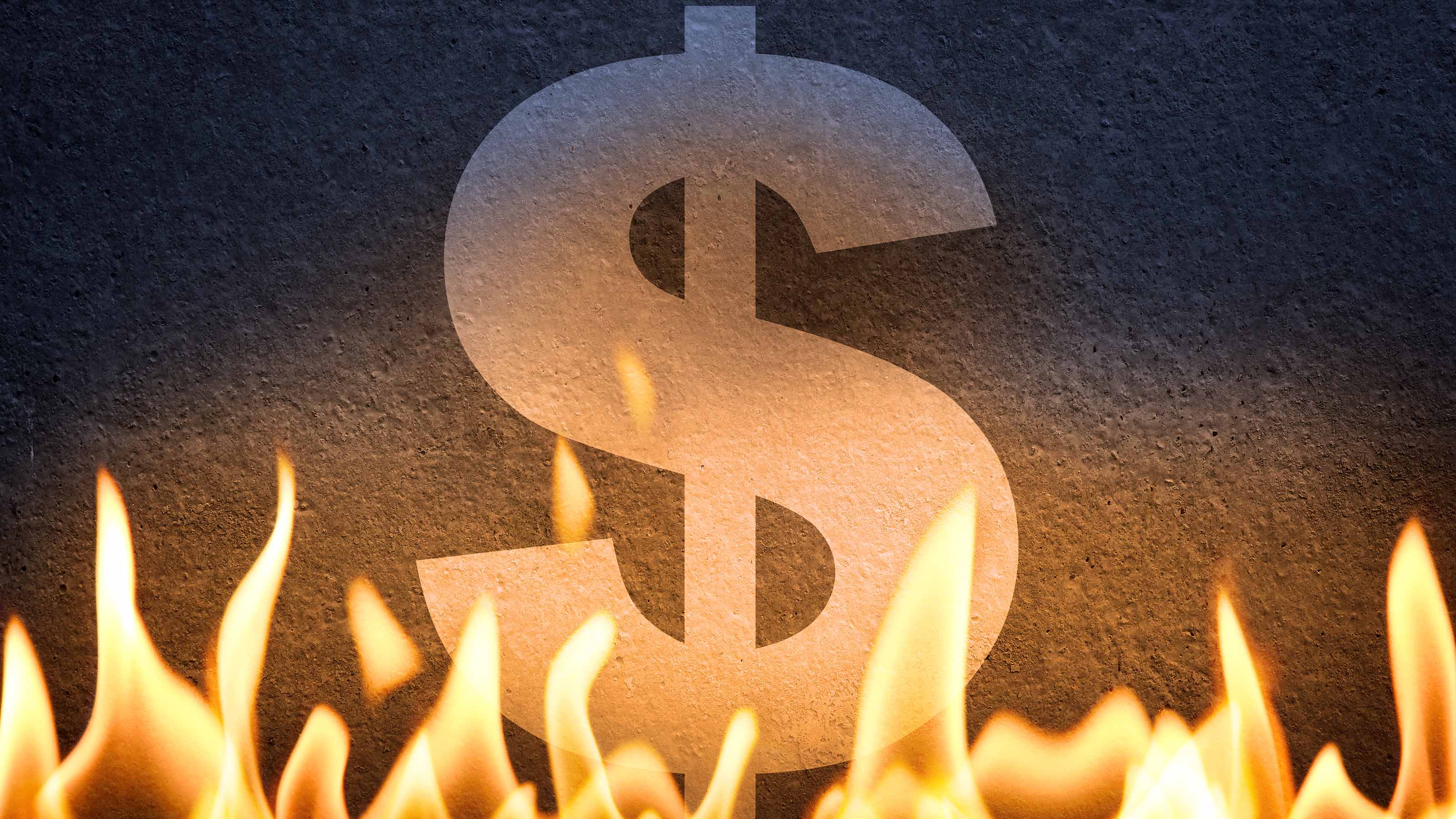March CPI Report Comes in Hot: What the Experts Are Saying About Inflation
A blowout inflation report pushes back the timing of Fed rate cuts.


A data-dependent Federal Reserve will likely push back the timing of its first interest rate cut after the Consumer Price Index (CPI) revealed that inflation accelerated sharply last month.
Headline inflation rose 0.4% in March, the Bureau of Labor Statistics said Wednesday, exceeding economists' forecast for a 0.3% increase. On an annual basis, headline inflation increased 3.5%. That was up from 3.2% a month ago and topped estimates for a 3.1% print.
Core CPI, which strips out volatile food and energy costs and is considered a better predictor of future prices, hit 0.4% month-to-month – just as it did the preceding two months. Economists were looking for core prices to increase just 0.3%. On an annual basis, core CPI rose 3.8%, as it did the prior month, vs expectations for a 3.7% increase.
From just $107.88 $24.99 for Kiplinger Personal Finance
Become a smarter, better informed investor. Subscribe from just $107.88 $24.99, plus get up to 4 Special Issues

Sign up for Kiplinger’s Free Newsletters
Profit and prosper with the best of expert advice on investing, taxes, retirement, personal finance and more - straight to your e-mail.
Profit and prosper with the best of expert advice - straight to your e-mail.
"Today's inflation figures likely close the door on a June rate cut, but the Fed is still highly motivated to get the cutting cycle started this year," says Lauren Goodwin, economist and chief market strategist at New York Life Investments.
Fed Chair Jerome Powell and the Federal Open Market Committee (FOMC) are looking for sustained evidence that inflation is down to 2% before they move to cut interest rates from a 23-year high. The latest CPI report likely changes their calculus, meaning it could be a while longer before we get monetary easing out of the next Fed meeting. Some even say three rate cuts in 2024 are now off the table.
As of April 10, futures traders assigned a 20% probability to the first quarter-point cut coming in June, down from 56% a day ago, according to CME Group's FedWatch Tool.
With the March CPI report now a matter of record, we turned to economists, strategists and other experts for their thoughts on what the data means for markets, macroeconomics and monetary policy going forward. Please see a selection of their commentary, sometimes edited for brevity or clarity, below.
Expert takes on the CPI report

"Today's hotter-than-anticipated CPI report pushes rate cuts to late 2024, if at all in 2024, signaling that the Federal Reserve's efforts to cool the economy and curb inflation are encountering substantial challenges. Today's headline reading was the highest since last September while U.S. Core CPI reaching 3.8% marks the first increase in core inflation since March 2023. This highlights the enduring inflationary pressures within the economy, and going forward we are keeping an eye on commodity prices which continue to rally and could further bolster inflation data in coming months." – Scott Acheychek, CEO of REX Shares
"This was a hot inflation number and not what the Fed was looking for. This pushes out the timing of the first rate cut because labor markets and the economy are strong, and now there's less urgency to cut. Today's inflation number was mostly driven by higher energy prices, medical care services and motor vehicle insurance. There were encouraging signs under the hood, as shelter continues its disinflation trend, food inflation eases and commodity prices outside energy and food pull back. Also, strong household consumption doesn't seem to be translating into higher prices for things like airfares, hotels, furniture, concert tickets and some personal care services." – Sonu Varghese, global macro strategist at Carson Group
"The March CPI inflation report is an unwelcome message to the markets that the Fed's inflation fight is far from over. Inflation remains the number one problem it still has yet to solve. Clearly, restrictive monetary policy has not yet fully done its work. A patient Fed with a Chair that is in 'no rush' to cut interest rates must be mulling the possibility that it may need to do more to put a stake in inflation's beating heart." – Scott Anderson, chief U.S. economist at BMO Capital Markets
"The March CPI data once again came in a bit too hot for comfort. Today's inflation data are likely to keep the FOMC's doves on the defensive while providing more ammunition to the committee's hawks, who are increasingly of the view that there is no urgency to start cutting the fed funds rate. We now project two quarter-point rate cuts in Q3 and Q4 of this year as our base case for the fed funds rate." – Sarah House, senior economist at Wells Fargo Economics
"Ouch. June is now a much longer shot." – Ian Shepherdson, chairman and chief economist at Pantheon Macroeconomics
"Ouch, this could leave a mark. Today’s CPI report is a stark reminder of the difficulties we could see as the Fed targets a sustainable move to their 2% target. While we have seen parts of the inflation picture return to a more 'normal' trend, goods are back in disinflationary territory, the more secular areas within core services and items like insurance, remain sticky at levels well above 2%. The shift in sentiment towards lower rates has been dramatic. After beginning the year with a market expectation of six or even seven rate cuts, we are now looking at virtually no chance for a move in May, June around 25%, July a 50/50 call and a total of only two rate cuts this year. The bond market is reacting swiftly with a quick 15-20 basis point upward shift and equity markets are down as the reality of higher rates for longer sets in." – Steve Wyett, chief investment strategist at BOK Financial
"CPI numbers came in hotter than expected for both core and headline. Headline and core CPI both exceeded expectations, rising 0.4% on the month. The Fed will not like these numbers, which keep the Fed's higher-for-longer narrative in play." – Rajeev Sharma, managing director of fixed income at Key Wealth
"Everyone was looking for shelter costs to come down but they're not cooperating. We have a strong economy, with tight inventories and pricing power for companies. That's now turning into a double-edged sword, making inflation stickier than we hoped. Rate cuts could be out the window." – David Russell, global head of market strategy at TradeStation
"These numbers affirm the risk of a resurgence in inflation driven by spillover effects from its more volatile components, particularly gasoline prices. Food and energy prices are much more susceptible to headwinds outside the Fed's control, including geopolitical tensions, supply shocks, as well as fiscal policy. However, long-term progress within core inflation, despite some speed bumps, still supports the efficacy of its wait-and-see approach toward segments of the economy more malleable to pressure from higher interest rates. These current inflation dynamics all but guarantee that interest rates remain steady after the Fed’s next meeting in April, and raise the bar for future inflation reports to provide the confidence required for lowering interest rates after June." – Noah Yosif, chief economist at the American Staffing Association
"Year-over-year CPI has once again come in hotter than anticipated. Today's reading marks inflation at its highest level since last September, fortifying recent Fed speak trying to tame investors' rate cut expectations. While cuts are certainly still on the table for 2024, today's data could be a key data point in pushing out pivot timing even further." – Ben Vaske, senior investment strategist at Orion Portfolio Solutions
"U.S. CPI inflation was hotter than expected yet again in March, narrowing the window further for Federal Reserve rate cuts. The past few months are consistent with our view that inflation will bottom out closer to 4% than 2%, and well above what is expected by the central bank and bond market. The Fed has been intent on lowering policy rates, but U.S. economy is sending a clear signal that it does not require easier policy, making rate cuts a policy misstep. Specifically, inflation is proving to be sticky, and we are seeing ongoing strength in corporate profits, consumer spending and employment, as well as a renewed pickup in manufacturing and housing activity." – Phillip Colmar, global strategist at MRB Partners
"We're still a far cry from the central bank's 2% target – and the policymakers will need to be a lot more convinced, and over a few months too, before they pivot.As such, we expect the Fed will delay a rate cut until the third quarter of this year. Then, we believe there will be a pause in order to assess the impact on the world's largest economy of the cut. This means that we believe the next rate cut after the one in the third quarter will be January 2025 at the earliest." – Nigel Green, founder and CEO of deVere
"Both headline and core CPI have come in hot every month of 2024 so far, which forces the issue on how many cuts the Fed will really be able to deliver this year. June is probably off the table at this point. Still, we should also stay mindful of other dynamics: year-ahead inflation expectations have trended lower, wage inflation has been decelerating, and economic growth still looks durable. The directional market reaction looks rational in the near term, but this year's improvement in risk sentiment is underpinned by other dynamics with staying power." – Elyse Ausenbaugh, global investment strategist at J.P. Morgan Global Wealth Management
"The general rule is to not prematurely claim victory or 'spike the football.' When inflation was falling for most of 2023, it couldn't get below that 3% and not only were markets cheering for it and calling for rate cuts, even the Federal Reserve and government officials were saying we beat inflation. Right on cue, inflation started heating back up. There was some nervousness coming into this report because January and February were a little hot, and it just got hotter in March. The dancing and celebrating has now probably stopped. The market is reacting like you might expect, it's down a pretty good amount since it had been hopeful for a rate cut. We went into this year with the market guessing six to seven rate cuts and now it looks like maybe it's going to be none." – Tim Courtney, chief investment officer at Exencial Wealth Advisors
Related Content
Profit and prosper with the best of Kiplinger's advice on investing, taxes, retirement, personal finance and much more. Delivered daily. Enter your email in the box and click Sign Me Up.

Dan Burrows is Kiplinger's senior investing writer, having joined the publication full time in 2016.
A long-time financial journalist, Dan is a veteran of MarketWatch, CBS MoneyWatch, SmartMoney, InvestorPlace, DailyFinance and other tier 1 national publications. He has written for The Wall Street Journal, Bloomberg and Consumer Reports and his stories have appeared in the New York Daily News, the San Jose Mercury News and Investor's Business Daily, among many other outlets. As a senior writer at AOL's DailyFinance, Dan reported market news from the floor of the New York Stock Exchange.
Once upon a time – before his days as a financial reporter and assistant financial editor at legendary fashion trade paper Women's Wear Daily – Dan worked for Spy magazine, scribbled away at Time Inc. and contributed to Maxim magazine back when lad mags were a thing. He's also written for Esquire magazine's Dubious Achievements Awards.
In his current role at Kiplinger, Dan writes about markets and macroeconomics.
Dan holds a bachelor's degree from Oberlin College and a master's degree from Columbia University.
Disclosure: Dan does not trade individual stocks or securities. He is eternally long the U.S equity market, primarily through tax-advantaged accounts.
-
 Are T-Mobile's Prepaid Perks a Home Run or a Strikeout?
Are T-Mobile's Prepaid Perks a Home Run or a Strikeout?T-Mobile's prepaid lineup promises MLB.TV, T-Mobile Tuesdays and hotspot data. But do the perks make it worth switching?
-
 Verizon Home Internet Is Offering Free Tech to New Customers
Verizon Home Internet Is Offering Free Tech to New CustomersVerizon’s latest home-internet promotion includes free tech, but the real savings depend on pricing, speed needs and how long you stay.
-
 Retirees in These 7 States Could Pay Less Property Taxes Next Year
Retirees in These 7 States Could Pay Less Property Taxes Next YearState Taxes Retirement property tax bills could be up to 65% cheaper for some older adults in 2026. Do you qualify?
-
 The November CPI Report Is Out. Here's What It Means for Rising Prices
The November CPI Report Is Out. Here's What It Means for Rising PricesThe November CPI report came in lighter than expected, but the delayed data give an incomplete picture of inflation, say economists.
-
 Online Banks Still Lead on Rates, But Is Switching Worth it Now?
Online Banks Still Lead on Rates, But Is Switching Worth it Now?As interest rates trend down, online banks keep an edge on yields, but service, access and flexibility still matter. Here’s how the trade-offs stack up.
-
 I'm 73, Retired, and Dreading Winter, But I Can't Afford to Be a Snowbird. Help!
I'm 73, Retired, and Dreading Winter, But I Can't Afford to Be a Snowbird. Help!How can a snowbird wannabe warm up without the expense? We asked professional wealth planners for advice.
-
 5 Smart Things to Do With Your Year-End Bonus, From a Financial Professional
5 Smart Things to Do With Your Year-End Bonus, From a Financial ProfessionalAfter you indulge your urge to splurge on a treat, consider doing adult things with the extra cash, like paying down debt, but also setting up a "fun fund."
-
 Are You a Gen X Investor? Here's How You Can Protect Your Portfolio From an AI Bubble
Are You a Gen X Investor? Here's How You Can Protect Your Portfolio From an AI BubbleAmid talk of an AI bubble, what's the best course of action for investors in their 50s and 60s, whose retirement savings are at risk from major market declines?
-
 Hey, Retirees: Put Your Charitable Gifts in a Donor-Advised Fund (and Enjoy Your Tax Break)
Hey, Retirees: Put Your Charitable Gifts in a Donor-Advised Fund (and Enjoy Your Tax Break)A donor-advised fund is a simple (really!), tax-smart strategy that lets you contribute a large, tax-deductible gift now and then distribute grants over time.
-
 Nasdaq Sinks 418 Points as Tech Chills: Stock Market Today
Nasdaq Sinks 418 Points as Tech Chills: Stock Market TodayInvestors, traders and speculators are growing cooler to the AI revolution as winter approaches.
-
 23 Last-Minute Gifts That Still Arrive Before Christmas
23 Last-Minute Gifts That Still Arrive Before ChristmasScrambling to cross those last few names off your list? Here are 23 last-minute gifts that you can still get in time for Christmas.